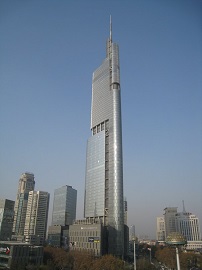Tall building
There is no established definition of what constitutes a ‘tall building’, instead there are several different criteria that typically determine whether a building can be considered to be tall.
Firstly, it is important to consider the urban context of the building. If a 10-storey building is in a central business district (CBD) surrounded by high-rise buildings of 20-storeys, then it may not be considered particularly tall. However, if a 10-storey building is in a suburban area that is predominantly low-rise, it would be considered to be a tall building. Historic England suggests that definitions of tall buildings should be 'based on evidence assessing the local context'. This means that definitions of what constitutes tall will vary from place to place. For example, Cambridge City Council defines a tall building as anything that 'breaks the existing skyline and/or is significantly taller than the surrounding built form'. Whereas Oxford has traditionally defined anything above the parapet height of the 18.2m Grade II-listed Carfax Tower as 'tall'. Ref https://historicengland.org.uk/whats-new/news/tall-buildings-advice-consultation/
Secondly, it can also be dependent on proportion. Buildings that are not particularly tall in terms of number of storeys can considered ‘tall’ if they are slender. Whereas, a building that is relatively tall but has a large footprint (such as a ‘groundscraper’) may not be considered ‘tall’.
The Council on Tall Buildings and Urban Habitat (CTBUH) defines a ‘supertall’ building as one that is more than 300 m (984 ft) in height. This classification is exceeded by ‘megatall’ buildings which are those exceeding 600 m (1,968 ft) in height.
The more general term ‘skyscraper’ refers to tall, continuously habitable buildings of 40 floors or more.
A high-rise building is defined variously as a building in which:
- The number of storeys means occupants need to use a lift to reach their destination
- The height is beyond the reach of available fire-fighting equipment.
- The height can have a serious impact on evacuation.
Other definitions include:
- A low-rise building is one which is not tall enough to be classified as high-rise.
- Mid-rise buildings of five to ten storeys, equipped with lifts.
- Super-slender buildings which are pencil-thin and of 50-90+ storeys.
The Hackitt Review published following the Grenfell Tower Fire considered that higher risk residential buildings (HRRB) were those of 10 storeys or more.
[edit] Related articles on Designing Buildings Wiki
Featured articles and news
The Building Safety Forum at the Installershow 2025
With speakers confirmed for 24 June as part of Building Safety Week.
The UK’s largest air pollution campaign.
Future Homes Standard, now includes solar, but what else?
Will the new standard, due to in the Autumn, go far enough in terms of performance ?
BSRIA Briefing: Cleaner Air, Better tomorrow
A look back at issues relating to inside and outside air quality, discussed during the BSRIA briefing in 2023.
Restoring Abbotsford's hothouse
Bringing the writer Walter Scott's garden to life.
Reflections on the spending review with CIAT.
Retired firefighter cycles world to raise Grenfell funds
Leaving on 14 June 2025 Stephen will raise money for youth and schools through the Grenfell Foundation.
Key points for construction at a glance with industry reactions.
Functionality, visibility and sustainability
The simpler approach to specification.
Architects, architecture, buildings, and inspiration in film
The close ties between makers and the movies, with our long list of suggested viewing.
SELECT three-point plan for action issued to MSPs
Call for Scottish regulation, green skills and recognition of electrotechnical industry as part of a manifesto for Scottish Parliamentary elections.
UCEM becomes the University of the Built Environment
Major milestone in its 106-year history, follows recent merger with London School of Architecture (LSE).
Professional practical experience for Architects in training
The long process to transform the nature of education and professional practical experience in the Architecture profession following recent reports.
A people-first approach to retrofit
Moving away from the destructive paradigm of fabric-first.
International Electrician Day, 10 June 2025
Celebrating the role of electrical engineers from André-Marie Amperè, today and for the future.
New guide for clients launched at Houses of Parliament
'There has never been a more important time for clients to step up and ...ask the right questions'
The impact of recycled slate tiles
Innovation across the decades.
EPC changes for existing buildings
Changes and their context as the new RdSAP methodology comes into use from 15 June.

























